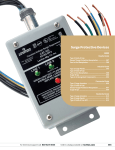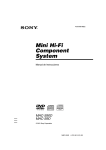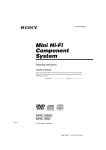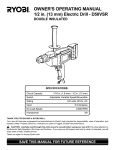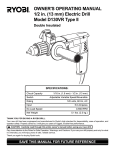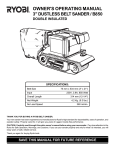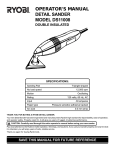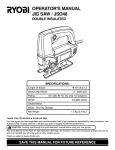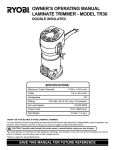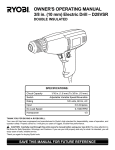Download Ryobi RS280 Operator`s manual
Transcript
OPERATOR'S MANUAL Random Orbit Sander Model RS280 DOUBLE INSULATED SPECIFICATIONS: Sanding disc diameter 5 in. (127 mm) Variable speed 0 - 13,000 opm Diameter of orbit 5/32 in. (4 mm) Rating Net weight 120 volts, 60 Hz, AC 2.8 Amperes 3.5 lbs. (1.6 kg.) THANK YOU FOR BUYING A RYOBI RANDOM ORBIT SANDER. Your new Random Orbit Sander has been engineered and manufactured to Ryobi's high standard for dependability, ease of operation, and operator safety. Properly cared for, it will give you years of rugged, trouble-free performance. CAUTION: Carefully read through this entire operator's manual before using your new sander. Pay close attention to the Rules for Safe Operation, Warnings, and Cautions. If you use your sander properly and only for what it is intended, you will enjoy years of safe, reliable service. Please fill out and return the Warranty Registration Card so we can be of future service to you. Thank you again for buying Ryobi tools. SAVE THIS MANUAL FOR FUTURE REFERENCE TABLE OF CONTENTS ■ ■ ■ ■ ■ ■ ■ ■ ■ Product Specifications ....................................................................................................................................... 1 Table Of Contents .............................................................................................................................................. 2 Rules For Safe Operation ............................................................................................................................... 2-4 Unpacking and Features ................................................................................................................................. 5-7 Operation ...................................................................................................................................................... 7-10 Maintenance .................................................................................................................................................... 11 Optional Accessories ....................................................................................................................................... 11 Exploded View and Parts List ..................................................................................................................... 12-13 Parts Ordering / Service .................................................................................................................................. 14 RULES FOR SAFE OPERATION The purpose of safety symbols is to attract your attention to possible dangers. The safety symbols, and the explanations with them, deserve your careful attention and understanding. The safety warnings do not by themselves eliminate any danger. The instructions or warnings they give are not substitutes for proper accident prevention measures. SYMBOL MEANING SAFETY ALERT SYMBOL: Indicates danger, warning, or caution. May be used in conjunction with other symbols or pictographs. DANGER: Failure to obey a safety warning will result in serious injury to yourself or to others. Always follow the safety precautions to reduce the risk of fire, electric shock and personal injury. WARNING: Failure to obey a safety warning can result in serious injury to yourself or to others. Always follow the safety precautions to reduce the risk of fire, electric shock and personal injury. CAUTION: Failure to obey a safety warning may result in property damage or personal injury to yourself or to others. Always follow the safety precautions to reduce the risk of fire, electric shock and personal injury. NOTE: Advises you of information or instructions vital to the operation or maintenance of the equipment. DOUBLE INSULATION IMPORTANT Double insulation is a concept in safety, in electric power tools, which eliminates the need for the usual three-wire grounded power cord. All exposed metal parts are isolated from the internal metal motor components with protecting insulation. Double insulated tools do not need to be grounded. Servicing of a tool with double insulation requires extreme care and knowledge of the system and should be performed only by a qualified service technician. For service we suggest you return the tool to your nearest RYOBI AUTHORIZED SERVICE CENTER for repair. When servicing use only identical Ryobi replacement parts. WARNING: WARNING: The double insulated system is intended to protect the user from shock resulting from a break in the tool's internal wiring. Observe all normal safety precautions related to avoiding electrical shock. Do not attempt to operate this tool until you have read thoroughly and understand completely all instructions, safety rules, etc. contained in this manual. Failure to comply can result in accidents involving fire, electric shock, or serious personal injury. Save operator's manual and review frequently for continuing safe operation, and instructing others who may use this tool. Page 2 RULES FOR SAFE OPERATION READ ALL INSTRUCTIONS ■ KNOW YOUR POWER TOOL. Read operator's manual carefully. Learn its applications and limitations as well as the specific potential hazards related to this tool. ■ GUARD AGAINST ELECTRICAL SHOCK by preventing body contact with grounded surfaces. For example: Pipes, radiators, ranges, refrigerator enclosures. ■ KEEP GUARDS IN PLACE and in working order. ■ KEEP WORK AREA CLEAN. Cluttered areas and benches invite accidents. ■ AVOID DANGEROUS ENVIRONMENT. Don't use power tool in damp or wet locations or expose to rain. Keep work area well lit. ■ KEEP CHILDREN AND VISITORS AWAY. All visitors should wear safety glasses and be kept a safe distance from work area. Do not let visitors contact tool or extension cord. ■ STORE IDLE TOOLS. When not in use tools should be stored in a dry and high or locked-up place - out of the reach of children. ■ DON'T FORCE TOOL. It will do the job better and safer at the rate for which it was designed. ■ USE RIGHT TOOL. Don't force small tool or attachment to do the job of a heavy duty tool. Don't use tool for purpose not intended - for example - A circular saw should never be used for cutting tree limbs or logs. ■ WEAR PROPER APPAREL. Do not wear loose clothing or jewelry that can get caught in the tool's moving parts and cause personal injury. Rubber gloves and nonskid footwear are recommended when working outdoors. Wear protective hair covering to contain long hair and keep it from being drawn into nearby air vents. ■ ALWAYS WEAR SAFETY GLASSES. Everyday eyeglasses have only impact-resistant lenses; they are NOT safety glasses. ■ PROTECT YOUR LUNGS. Wear a face or dust mask if operation is dusty. ■ PROTECT YOUR HEARING. Wear hearing protection during extended periods of operation. ■ DON'T ABUSE CORD. Never carry tool by cord or yank it to disconnect from receptacle. Keep cord from heat, oil and sharp edges. ■ SECURE WORK. Use clamps or a vise to hold work. It's safer than using your hand and it frees both hands to operate the tool. ■ DON'T OVERREACH. Keep proper footing and balance at all times. Do not use while standing on a ladder or unstable support. ■ MAINTAIN TOOLS WITH CARE. Keep tools sharp at all times, and clean for best and safest performance. Follow instructions for lubricating and changing accessories. ■ DISCONNECT TOOLS. When not in use, before servicing, or when changing or adjusting attachments, blades, bits, cutters, sandpaper, etc., all tools should be disconnected from power supply. ■ REMOVE ADJUSTING KEYS AND WRENCHES. Form habit of checking to see that keys and adjusting wrenches are removed from tool before turning it on. ■ AVOID ACCIDENTAL STARTING. Don't carry plugged-in tools with finger on switch. Be sure switch is off when plugging in. ■ MAKE SURE YOUR EXTENSION CORD IS IN GOOD CONDITION. When using an extension cord, be sure to use one heavy enough to carry the current your product will draw. An undersized cord will cause a drop in line voltage resulting in loss of power and overheating. A wire gage size (A.W.G.) of at least 16 is recommended for an extension cord 100 feet or less in length. A cord exceeding 100 feet is not recommended. If in doubt, use the next heavier gage. The smaller the gage number, the heavier the cord. ■ OUTDOOR USE EXTENSION CORDS. When tool is used outdoors, use only extension cords suitable for use outdoors. Outdoor approved cords are marked with the suffix W-A, for example - SJTW-A or SJOW-A. ■ NEVER USE THIS OR ANY POWER SANDER FOR WET SANDING OR LIQUID POLISHING. Failure to comply can result in electrical shock causing serious injury or worse. ■ KEEP HANDS AWAY FROM SANDING AREA. ■ NEVER USE IN AN EXPLOSIVE ATMOSPHERE. Normal sparking of the motor could ignite fumes. Page 3 RULES FOR SAFE OPERATION ■ INSPECT TOOL CORDS PERIODICALLY and if damaged, have repaired at your nearest authorized service center. Stay constantly aware of cord location. ■ INSPECT EXTENSION CORDS PERIODICALLY and replace if damaged. ■ KEEP HANDLES DRY, CLEAN, AND FREE FROM OIL AND GREASE. Always use a clean cloth when cleaning. Never use brake fluids, gasoline, petroleum-based products or any strong solvents to clean your tool. ■ STAY ALERT. Watch what you are doing and use common sense. Do not operate tool when you are tired. Do not rush. ■ CHECK DAMAGED PARTS. Before further use of the tool, a guard or other part that is damaged should be carefully checked to determine that it will operate properly and perform its intended function. Check for alignment of moving parts, binding of moving parts, breakage of parts, mounting, and any other conditions that may affect its operation. A guard or other part that is damaged should be properly repaired or replaced by an authorized service center unless indicated elsewhere in this instruction manual. ■ DO NOT USE TOOL IF SWITCH DOES NOT TURN IT ON AND OFF. Have defective switches replaced by an authorized service center. ■ INSPECT FOR and remove all nails from lumber before sanding. ■ DRUGS, ALCOHOL, MEDICATION. Do not operate tool while under the influence of drugs, alcohol, or any medication. ■ WHEN SERVICING USE ONLY IDENTICAL RYOBI REPLACEMENT PARTS. ■ MAKE THE WORKSHOP CHILD-PROOF with padlocks, master switches, or by removing starter keys. ■ POLARIZED PLUGS. To reduce the risk of electric shock, this tool has a polarized plug (one blade is wider than the other). This plug will fit in a polarized outlet only one way. If the plug does not fit fully in the outlet, reverse the plug. If it still does not fit, contact a qualified electrician to install the proper outlet. Do not change the plug in any way. ■ SAVE THESE INSTRUCTIONS. Review them frequently and use them to instruct others who may use this tool. If you loan someone this tool, loan them these instructions also. WARNING: WEAR YOUR SAFETY GLASSES FORESIGHT IS BETTER THAN NO SIGHT The operation of any sander can result in foreign objects being thrown into your eyes, which can result in severe eye damage. Before beginning power tool operation, always wear safety goggles or safety glasses with side shields and a full face shield when needed. We recommend Wide Vision Safety Mask for use over eyeglasses or standard safety glasses with side shields. Look for this symbol to point out important safety precautions. It means attention!!! Your safety is involved. SAVE THESE INSTRUCTIONS Page 4 UNPACKING ■ Carefully remove the sander, and accessories from box. Make sure all items listed in the Packing List are included. ■ Do not discard the packing material until you have carefully inspected and satisfactorily operated sander. ■ Examine all parts and accessories to make sure that no breakage has occurred during shipping. Any damaged part should be replaced before attempting to use the tool. ■ If any parts are damaged or missing, contact your nearest Ryobi dealer to obtain replacement parts before attempting to operate sander. Page 5 PACKING LIST Sanding Disc Conversion Pad (for velcro type sanding discs) Warranty Card Operator's Manual FEATURES KNOW YOUR SANDER VARIABLE SPEED See Figure 1. Before attempting to use your sander, familiarize yourself with all operating features and safety requirements. See figure 1. Your sander has a variable speed control selector designed to allow operator control and adjustment of speed. The speed of your sander can be increased or decreased by rotating the variable speed control selector in the direction of the arrows shown in figure 1. Note: Hold your sander in normal operating position and turn the variable speed control selector counterclockwise to increase speed. Turn clockwise to decrease speed. If you desire to lock the switch on at a given speed, depress the switch trigger, push in and hold the lock-on button, and release the switch trigger. Next, adjust the variable speed control selector until the desired speed is reached. Note: If the variable speed control selector is fully turned in the clockwise direction (zero setting) your sander may not run. Note: If you desire not to use the variable speed control selector, turn it in the full counterclockwise direction. This will allow the speed of your sander to be controlled by the amount of switch trigger depression. The following guidelines may be used in determining correct speed for various applications. Low speed is ideal when using tool as a buffer or polisher. High speed should be used for sanding. WARNING: If any parts are missing do not operate your sander until the missing parts are replaced. Failure to do so could result in possible serious injury. Your sander is suitable for sanding with coarse, medium, and fine grit sanding discs. It includes a dust box for dustless sanding. SWITCH This tool is equipped with a simple switch control. To turn your sander ON, depress the switch trigger. See Figure 1. Release the switch trigger to turn your sander OFF. LOCK-ON-BUTTON See figure 1. Your sander is equipped with a "lock-on" feature, which is convenient when continuous sanding for extended periods of time is required. To lock-on, depress the switch trigger, push in and hold the lock-on button located on the side of the handle, then release switch trigger. Release lock-on button and your sander will continue running. To release the lock, depress switch trigger and release it. If you have the "lock-on" feature engaged during use and your sander becomes disconnected from power supply, disengage the "lock-on" feature immediately. FRONT HANDLE CONVERSION PAD Converts the standard sanding pad from use with pressure sensitive sanding discs for use with velcro type sanding discs. TO DECREASE SPEED LOCK-ON BUTTON REAR HANDLE VARIABLE SPEED CONTROL SELECTOR SWITCH TRIGGER TO INCREASE SPEED BACKING PAD DUST BOX SANDING DISC Fig. 1 Page 6 FEATURES RANDOM ORBIT The random orbit motion provides overlapping sanding movements by combining orbital and turning motion. These overlapping sanding movements provide fast cutting action with excellent sanding results. WARNING: Do not allow familiarity with your sander to make you careless. Remember that a careless fraction of a second is sufficient to inflict severe injury. ELECTRICAL CONNECTION Your sander has a precision built electric motor. It should be connected to a power supply that is 120 volts, 60 Hz, AC only (normal household current). Do not operate this tool on direct current (DC). A substantial voltage drop will cause a loss of power and the motor will overheat. If your tool does not operate when plugged into an outlet, double-check the power supply. APPLICATIONS (Use only for the purposes listed below) ■ Sanding on wood surfaces. ■ Removing rust from and sanding steel surfaces. OPERATION The backing pad on your sander provides the capability to use sanding discs with pressure sensitive adhesive backing material. You also receive a conversion pad which allows use of sanding discs with velcro type backing material. ADHESIVE SANDING DISC WARNING: BACKING PAD Your sander should never be connected to power supply when you are assembling parts, making adjustments, assembling or replacing sanding disc, cleaning, or when not in use. Disconnecting your sander will prevent accidental starting that could cause serious personal injury. TO ATTACH PRESSURE SENSITIVE ADHESIVE SANDING DISC See Figure 2. ■ Unplug your sander. Fig. 2 WARNING: SANDING DISC SELECTION Failure to unplug your sander could result in accidental starting causing possible serious personal injury. ■ Carefully peel paper backing from the pressure sensitive adhesive type sanding disc. ■ Align holes in sanding disc with holes in backing pad, then carefully press sticky side of disc against pad as tight as possible. Note: Holes in sanding disc must line up with holes in the backing pad in order for the dustless feature of your sander to function properly. Note: It is recommended that you clean backing pad occasionally by brushing lightly with a small brush. Dust build-up on backing pad could cause sanding disc not to stick properly. Selecting the correct size grit and type sanding disc is an extremely important step in achieving a high quality sanded finish. Aluminum oxide, silicon carbide, and other synthetic abrasives are best for power sanding. Natural abrasives, such as flint and garnet are too soft for economical use in power sanding. In general, coarse grit will remove the most material and finer grit will produce the best finish in all sanding operations. The condition of the surface to be sanded will determine which grit will do the job. If the surface is rough, start with a coarse grit and sand until the surface is uniform. Medium grit may then be used to remove scratches left by the coarser grit and finer grit used for finishing of the surface. Always continue sanding with each grit until surface is uniform. Page 7 OPERATION REMOVING SANDING DISC BEFORE STORAGE Do not store your sander with the sanding disc installed. Heat generated from sanding causes the pressure sensitive adhesive to flow and form a tight bond between the backing pad and sanding disc. Removing the sanding disc soon after you have finished a sanding operation avoids letting the adhesive set up. If the sanding disc is left on the backing pad for an extended period of time after use, the adhesive will set up and cause the sanding disc to become difficult to remove. It may also tear when removing. When this situation occurs, it becomes difficult to clean the backing pad for the next sanding disc. Note: If you forget to remove the sanding disc after a sanding operation, sand for a few minutes to soften the adhesive backing before attempting to remove sanding disc. WARNING: To prevent the possibility of sanding dust or foreign objects being thrown into your face or eyes, never attempt to use your sander without the dust box properly installed. Sanding dust or foreign objects being thrown into your face could result in possible serious personal injury. TO ATTACH CONVERSION PAD AND VELCRO TYPE SANDING DISC See Figure 3. The conversion pad provided with your sander has a pressure sensitive adhesive backing material. It is applied by the same method as pressure sensitive adhesive paper. ■ Unplug your sander. VELCRO TYPE SANDING DISC CONVERSION PAD BACKING PAD WARNING: Failure to unplug your sander could result in accidental starting causing possible serious personal injury. ■ Carefully peel paper backing from the conversion pad and align with holes in backing pad. Firmly press sticky side of conversion pad against backing pad. Your sander is now ready to use velcro type sanding discs. ■ Align holes in velcro type sanding disc with holes in conversion pad, then carefully press fuzzy side of sanding disc against pad as tight as possible. Note: Velcro type sanding discs can be reused for the life of the sanding abrasive. It is recommended that you keep the sanding disc backing and the conversion pad clean to provide the best attachment. Clean occasionally by brushing lightly with a small brush. Fig. 3 DUSTLESS SANDING See Figures 4 and 5. The dust box located on the rear of your sander provides a dust collection system for your sander. Sanding dust is drawn up through the holes of the sanding disc to collect in the dust box during sanding operation. Note: For more efficient operation, empty dust box when half full. This will permit the air to flow through the box better. TABS TO REMOVE Page 8 Fig. 4 OPERATION REMOVING DUST BOX See Figure 4. ■ Unplug your sander. WARNING: Failure to unplug your sander could result in accidental starting causing possible serious personal injury. ■ To release dust box, depress tabs located on each side of dust box. ■ Slide dust box down and lift from sander as shown by the arrows in figure 4. ■ Do not press on the filter material with your hand or fingers. Filter material can be damaged. Note: Filter material is located on sides of dust box. ■ Do not break tabs that secure dust box to sander. ■ Empty dust box. TABS TO INSTALL DUST BOX TABS Fig. 5 TO INSTALL DUST BOX See Figure 5. ■ Realign dust box with rear of sander. ■ Slide dust box on sander as shown in figure 5. You will feel a soft click as the tab snaps into place. Note: As mentioned above, be careful not to break the tabs that secure dust box to sander. EXTENSION CORDS The use of any extension cord will cause some loss of power. To keep the loss to a minimum and to prevent tool from overheating, use an extension cord that is heavy enough to carry the current the tool will draw. A wire gage size (A.W.G.) of at least 16 is recommended for an extension cord 100 feet or less in length. When working outdoors, use an extension cord that is suitable for outdoor use. The cord's jacket will be marked WA. CAUTION: WARNING: Do not use this product as a component of other products. Also, do not use attachments or accessories not recommended for use with this product. Any such use could result in possible serious personal injury. WARNING: To ensure proper brake operation after extended use, periodically check its operation by removing the sanding disc and running your sander without load (off the workpiece). The backing pad should not take longer than 6 seconds to stop. If it takes longer than 6 seconds to stop, return the sander to your nearest RYOBI AUTHORIZED SERVICE CENTER for repair. Keep extension cords away from the sanding area and position the cord so that it will not get caught on lumber, tools, etc., during sanding. WARNING: Do not wear loose clothing or jewelry when operating sander. They could get caught in moving parts causing serious injury. Keep head away from sander and sanding area. Hair could be drawn into sander causing serious injury. WARNING: Check extension cords before each use. If damaged replace immediately. Never use tool with a damaged cord since touching the damaged area could cause electrical shock resulting in serious injury. WARNING: Before connecting your sander to power supply source, always check to be sure the switch is not in ON position. Failure to do so could result in accidental starting of your sander resulting in possible serious injury. Page 9 OPERATION PREPARING FOR OPERATION CAUTION: Be careful not to let your hand cover the air vents. For ease of operation, your sander has both a front handle and rear handle. See Figure 6. This provides for two-hand operation, which is necessary in order to maintain proper control of your sander and keep both hands clear of the sanding disc and sanding area. When operating your sander, always use both hands. See Figures 6 and 7. Flush sanding can be performed with your sander when the front handle is removed from sander. See Figure 7. Remove front handle by depressing tab under front handle while pulling handle up and off of sander. See Figure 8. Fig. 6 SANDING See Figures 6 and 7. Clamp or otherwise secure the work to prevent it from moving under your sander. WARNING: Unsecured work could be thrown towards the operator causing injury. Place sander on workpiece so that all of sanding disc surface is in contact with workpiece. Start your sander and move it slowly over workpiece making successive passes in parallel lines, circles, or crosswise movements. Upon completion of sanding operation, turn sander off and wait until sanding disc comes to a complete stop before removing from workpiece. DO NOT FORCE. The weight of the unit supplies adequate pressure, so let the sanding disc and sander do the work. Applying additional pressure only slows the motor, rapidly wears sanding disc and greatly reduces sander speed. Excessive pressure will overload the motor causing possible damage from motor overheating and can result in inferior work. Any finish or resin on wood may soften from the frictional heat. Do not allow sanding on one spot too long as the sander's rapid action may remove too much material, making the surface uneven. Extended periods of sanding may tend to overheat the motor. If this occurs, turn sander off and wait until sanding disc comes to a complete stop, then remove it from workpiece. Remove your hand from vent area, remove sanding disc, then with your hand removed from vent area, turn sander on and run it free without a load to cool motor. As mentioned previously, flush sanding can be performed with your sander. As shown in Figure 7, the front edge of your sander allows flush sanding. Upon completion of sanding operation, turn sander off and wait until sanding disc comes to a complete stop before removing from workpiece. Page 10 Fig. 7 FRONT HANDLE TAB TO REMOVE TO INSTALL Fig. 8 MAINTENANCE WARNING: When servicing use only identical Ryobi replacement parts. Use of any other parts may create a hazard or cause product damage. GENERAL Avoid using solvents when cleaning plastic parts. Most plastics are susceptible to damage from various types of commercial solvents and may be damaged by their use. Use clean cloths to remove dirt, carbon dust, etc. WARNING: Do not at any time let brake fluids, gasoline, petroleumbased products, penetrating oils, etc. come in contact with plastic parts. They contain chemicals that can damage, weaken, or destroy plastic. LUBRICATION All of the bearings in this tool are lubricated with a sufficient amount of high grade lubricant for the life of the unit under normal operating conditions. Therefore, no further lubrication is required. When electric tools are used on fiberglass boats, sports cars, wallboard, spackling compounds, or plaster, it has been found that they are subject to accelerated wear and possible premature failure, as the fiberglass chips and grindings are highly abrasive to bearings, brushes, commutators, etc. Consequently, it is not recommended that this tool be used for extended work on any fiberglass material, wallboard, spackling compounds, or plaster. During any use on these materials it is extremely important that the tool is cleaned frequently by blowing with an air jet. WARNING: Always wear safety goggles or safety glasses with side shields during power tool operation or when blowing dust. If operation is dusty, also wear a dust mask. OPTIONAL ACCESSORIES The following recommended accessories are current and were available at the time this manual was printed: 4600040 40 Grit Sanding Disc 5 Per Pack 4600150 150 Grit Sanding Disc 5 Per Pack 4600060 60 Grit Sanding Disc 5 Per Pack 4600220 220 Grit Sanding Disc 5 Per Pack 4600080 80 Grit Sanding Disc 5 Per Pack 4600320 320 Grit Sanding Disc 5 Per Pack 4600100 100 Grit Sanding Disc 5 Per Pack 4600503 Conversion Pad 2 Per Pack All individual sanding grits are available in handy five sheet packs. Page 11 RYOBI SANDER – MODEL NUMBER RS280 12 11 10 11 10 4 5 13 14 8 APPLY A THIN COAT OF LOCTITE ADHESIVE NO. 380 (BLACK MAX) TO THIS SURFACE 9 6 Page 12 15 24 23 3 22 16 7 APPLY A THIN COAT OF GREASE TO THIS SURFACE 2 5 24 17 18 19 25 20 1 28 21 25 21 26 25 27 WARNING: Improper repair of a double insulated tool can result in damages to the double insulation system possibly causing electrical shock or electrocution. Any repairs requiring disassembly of your tool requires safety testing and should only be performed by a Ryobi Authorized Service Center. For the repair center nearest you call 1-800-525-2579 in the United States or 1-800-265-6778 in Canada. RYOBI SANDER – MODEL NUMBER RS280 The model number will be found on a plate attached to the motor housing. Always mention the model number in all correspondence regarding your SANDER or when ordering repair parts. PARTS LIST Key No. Part Number Description Quan. Key No. Part Number Description Quan. Page 13 1 969533-002 Dust Box .............................................................. 1 16 973714-003 Counterbalance ................................................... 1 2 990496-016 Cord ..................................................................... 1 17 968305-047 Bearing Cap w/Bearing ....................................... 1 3 970099-002 Seal ...................................................................... 1 18 703493-818 Washer ................................................................ 1 4 973712-001 Logo Plate ........................................................... 1 19 969649-001 Screw (#8-32 x 1/2 in. Pan Hd.) .......................... 1 5 970113-001 Housing Assembly ............................................... 1 20 975241-002 Backing Pad ........................................................ 1 6 969896-001 Small Gasket ....................................................... 1 21 998586-001 Screw (#10-32 x 1/4 in. Pan Hd.) ........................ 4 7 968303-006 Switch .................................................................. 1 22 969645-001 Front Handle ........................................................ 1 8 968775-001 Screw (M3 x 7 Fil. Hd.) ........................................ 2 23 623552-003 Stator Pad ............................................................ 1 9 969421-007 Lead ..................................................................... 1 24 623019-004 Rubber Plug ......................................................... 2 10 968304-013 Brush Assembly ................................................... 2 25 968700-011 Screw (#6-19 x 3/4 in. Pan Hd.) .......................... 5 11 999186-001 Brush Tube .......................................................... 2 26 981334-001 Data Plate ............................................................ 1 12 968305-009 Ball Bearing (NTN#608ZZ/1E) ............................ 1 27 973887-003 Sanding Disc ....................................................... 1 13 968307-114 Field ..................................................................... 1 28 974484-001 Conversion Pad ................................................... 1 14 968306-119 Armature .............................................................. 1 972000-702 Operator’s Manual 15 973713-001 Skirt ...................................................................... 1 * Standard Hardware Item — May Be Purchased Locally OPERATOR'S MANUAL Random Orbit Sander Model RS280 Double Insulated EXTENSION CORD CAUTION When using a power tool at a considerable distance from a power source, be sure to use an extension cord that has the capacity to handle the current the tool will draw. An undersized cord will cause a drop in line voltage, resulting in overheating and loss of power. Use the chart to determine the minimum wire size required in an extension cord. Only round jacketed cords should be used. When working with a tool outdoors, use an extension cord that is designed for outside use. This is indicated by the letters "WA" on the cord's jacket. Before using any extension cord, inspect it for loose or exposed wires and cut or worn insulation. **Ampere rating (on tool data plate) 0-2.0 Cord Length 2.1-3.4 3.5-5.0 5.1-7.0 7.1-12.0 12.1-16.0 Wire Size (A.W.G.) 25' 16 16 16 16 14 14 50' 16 16 16 14 14 12 100' 16 16 14 12 10 — CAUTION: Keep the extension cord clear of the working area. Position the cord so that it will not get caught on workpiece, tools, or other obstructions while you are working with a power tool. **Used on 12 gauge - 20 amp circuit. • SERVICE Now that you have purchased your tool, should a need ever exist for repair parts or service, simply contact your nearest Ryobi Authorized Service Center. Be sure to provide all pertinent facts when you call or visit. Please refer to the Service Center insert or call 1-800-525-2579 in the United States or 1-800-265-6778 in Canada for your nearest Ryobi Authorized Service Center. You can also check our web site at www.ryobi.com for a complete list of Authorized Service Centers. • MODEL NO. AND SERIAL NO. The model number and serial number of this tool will be found on a plate attached to the motor housing. Please record the serial number in the space provided below. • MODEL NUMBER • SERIAL NUMBER RS280 RYOBI AMERICA CORP. 1424 Pearman Dairy Road Anderson, SC 29625 Post Office Box 1207 Anderson, SC 29622-1207 Phone 1-800-525-2579 972000-702 RYOBI CANADA INC. Post Office Box 910 Cambridge, Ontario N1R 6K2 Phone 1-800-265-6778 Printed in U.S.A.














